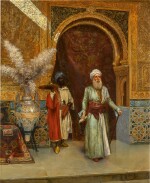The Silk Road: Orientalist Paintings and Furniture from a Belgravia Residence
The Silk Road: Orientalist Paintings and Furniture from a Belgravia Residence

Clemente Pujol de Gustavino
Leaving the Mosque
Auction Closed
November 9, 04:41 PM GMT
Estimate
40,000 - 60,000 GBP
Lot Details
Description
Clemente Pujol de Gustavino
Spanish
1850 - 1905
Leaving the Mosque
signed G. Pujol lower right
oil on panel
Unframed: 65 by 53.5cm., 25½ by 21in.
Framed: 83.5 by 72cm., 32¾ by 28¼in.
Mathaf Gallery, London
Acquired from the above by the present owner
Acquired from the above by the present owner
Pujol belonged to the school of nineteenth-century Spanish painters who made their careers in Paris. Training first at the Academy of Barcelona, in 1876 he moved to Paris to continue his studies in the studios of Louis Labat and later Jean-Léon Gérôme. In Paris, Pujol knew the leading Spanish painter in Paris at the time, Raimundo de Madrazo, as well as Léon Bonnat, and through Gérôme met the dealer Adolphe Goupil who offered him a contract. His interest in Orientalist subjects stemmed from his time with Gérôme, but also from his admiration of the work of his countrymen Mariano Fortuny and José Villegas Cordero. No doubt he also fraternized with the highly successful Austrian Orientalists active in Paris, notably Rudolf Ernst, with whose technique, including the etched paint surface evident in the present work, Pujol’s has much in common. As well as visiting Andalusia in search of Moorish subjects, it is likely, based on the inscription Tanger found on some of his works, that he travelled to Morocco for further inspiration. Certainly, his Andalusian and Moroccan subjects met with critical acclaim, and at the Exposition Universelle of 1889 he was represented by, and awarded a medal for, his Orientalist painting, Moorish Dance.
